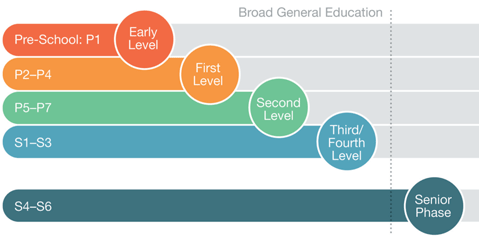Broad general education
 The Broad General Education is the phase of learning which lasts from when a child begins early learning and childcare through to the end of S3 in secondary school before moving on to the senior phase of the curriculum in S4 to S6. This broad general education provides your child with a wide range of knowledge, skills and exciting experiences that they can draw on as their lives, careers and job opportunities continue to change.
The Broad General Education is the phase of learning which lasts from when a child begins early learning and childcare through to the end of S3 in secondary school before moving on to the senior phase of the curriculum in S4 to S6. This broad general education provides your child with a wide range of knowledge, skills and exciting experiences that they can draw on as their lives, careers and job opportunities continue to change.
There are four broad levels in which learning and achievement are organised. To support teachers’ assessment of learning, benchmarks have been developed to describe what learning should look like by the time a learner completes a level in each curriculum area. Not all benchmarks need to be achieved for a child or young person to have achieved a level. However, it is important that there are no significant gaps in learning before moving on to the next level.
Curriculum levels
Curriculum levels are national levels to describe different stages of learning and progress. For most children the expectation is:

Throughout the Broad General Education, children and young people are assessed and decisions are made by teachers on when a child or young person has achieved learning at a particular level. This means that they have broadly covered the experiences and achieved the expected outcomes for that level. In making this decision, the teacher takes into account the evidence mentioned above, and considers the benchmarks produced by Education Scotland for each level as well as diagnostic feedback from the Scottish National Standardised Assessments (SNSA).
Benchmarks have been developed to provide clarity on the national standards expected within each curriculum area at each level. They set out clear lines of progression in literacy and English and numeracy and mathematics, and across all other curriculum areas.
With the Scottish National Standardised Assessments, learners in P1, P4, P7 and S3 complete online standardised assessments in reading, writing and numeracy as part of everyday learning and teaching. This type of assessment helps to identify children and young people’s progress by providing diagnostic information to support teachers' professional judgement. It is important to note that no one piece of assessment information, such as the result of a standardised assessment, gives the teacher enough evidence on which to make a judgement on learning. Instead, teachers’ professional judgements are supported through the process of moderation in which colleagues meet to discuss and evaluate a range of assessment evidence taken from children and young people’s learning. This process ensures teachers have a shared understanding of standards and expectations as expressed in the National Benchmarks.
Data from across Scotland on achievement of Curriculum for Excellence Levels is reported to the Scottish Government annually and as part of the overall statistical evidence to inform how well learners are progressing in Scotland.
What will my child learn during their broad general education?
Each curriculum area in the broad general education is planned around a nationally agreed programme of experiences and outcomes (often called Es and Os). These describe the knowledge, skills, attributes and capabilities that young people are expected to develop.
Learning in the broad general education may often span a number of curriculum areas (for example a literacy project planned around science and technology might include outdoor learning experiences, research and the use of ICT). There is likely to be themed and project learning, as well as wider opportunities to show how skills and knowledge can be used in challenging, different and interesting ways. The term often used for this is interdisciplinary learning.
More information on the broad general education
This downloadable document has further information about the period of the broad general education, including how learning is assessed, understanding your child's progress and making choices for qualifications.
Note: Although the document refers to secondary schools, much of the information is relevant for the broad general education as a whole.
Broad General Education in the Secondary School – A Guide for Parents and Carers (PDF 1.6 MB)
